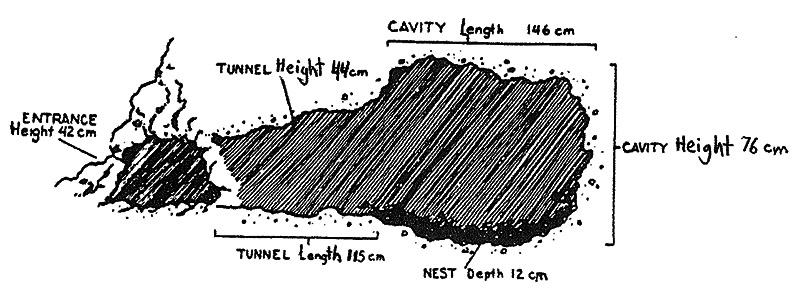
Building a Bear Den
As our state mammal and as the symbol of the Department of Game and Fish, black bears are truly an iconic animal for New Mexico. Black bears have a high degree of intelligence and are respected by all the diverse cultures of our state. Their ability to survive and give birth during the winter in their den is just one of the many fascinating aspects of their life history.
Overview
Overview: Students replicate a bear den in the classroom in an inter-disciplinary activity that incorporates science, mathematics, and basic design and engineering skills.
Grade level: 3rd-5th grade; Note: Math content is more suited for 4th-5th grades.
Content Areas: Science, math, language arts/writing
Objectives:
- After building a bear den replica in the classroom students will be able to discuss the basic habitat needs for a black bear in the winter in New Mexico.
- Students will understand how to convert centimeters to inches, how to calculate averages from sets of numbers and how to calculate volume and perimeter.
- They will understand the differences in hibernation and a deep sleep or torpor, how different habitats result in different kinds of black bear dens and what black bears need to survive the winter.
- Students will be able to discuss and explain the various steps and thought processes behind their bear den project; how they took the various measurements of a bear den and made their calculations, found readily available materials to construct the den, how they put it all together and what the purpose and function was of each part of the den.
Method: Students learn about black bear biology and hibernation by building a replica bear den in the classroom. Students use original data from black bear dens to do mathematic operations; calculate volume and perimeter, calculate the average dimensions of the entrance opening, the tunnel, and actual cavity or main room. Students use measuring skills to mark out and (if age appropriate) do the actual cutting out and fabrication of needed materials (cardboard etc.) to create the den.
Materials for Introduction of Lesson:
Measuring tape
large cardboard boxes
newspaper
colored masking tape
folding chairs
art supplies e.g. markers, crayons.
Lesson and Activity Time: Two 45-50 minute classroom sessions for basic activity; additional classroom time for extension
Location: Indoors or possibly outside depending on what is available.
Common Core Standards:
Mathematics:
Grade 3-Number Base Ten- NBT.1,2,3.
Measurement Data- MD.3,4,5,7.
Geometery-G.1,2.Grade 4- Measurement Data-MD.1,3,4
English Language Arts/Literacy:
Grade 4-Reading Informational Text-RI.1,3,4,5,7
Writing-W.4,5,6,7,8,9,10.
Speaking Listening-SL.1,2.
Language Standards-L.1,2,4b,4c,6.Grade 5-
Reading Informational Text-RI.7
Speaking and Listening- SL.5New Mexico Science Standards:
Strand II: Content of Science, Standard II Life Science, K-4 Benchmark I-II.3rd grade, Standard II:Benchmark I: 1.
5th Grade, Strand I: Scientific Thinking and Practice
Standard I: Grades 5-8 Benchmark I: 1,2,3.
Background
Vocabulary: Hibernation, torpor, habitat, den, metabolism, defecate, urinate, mature
Background Information for Educators:
The American black bear is the smallest of the three species of bears found in North America and the only bear found in New Mexico (grizzly bears were extirpated (gone from New Mexico) by the 1930s). Black bears are scattered throughout the state in forested mountainous habitats-especially around stands of oak, pinyon and juniper. Black bear hunting opportunities are offered around the state. For many sportsmen pursuing bears is an exciting form of recreation as well as a method for managing a healthy population. Around 2,300 hunters search for black bear in New Mexico each year; approximately 550 hunters take a bear each year.
Black bears go into a deep sleep (torpor) during the winter in New Mexico as an adaptation to the lack of food. In the den bears do not eat, drink, defecate or urinate while in their deep sleep. Adults save energy by lowering their metabolic rate by up to 50%. Their heart rate goes down to 12-15 beats a minute and their temperature goes down to 47 degrees Fahrenheit. Although bears are definitely in a deep sleep they can still be woken up and aroused. This allows a bear to protect itself or its cubs from predators invading the den. By the end of the winter they may lose about 20 percent of their body weight.
Hibernation or Winter Sleep? Black bears in New Mexico and in most of the West know exactly what to do each year when fall begins to turn to winter. They simply enter their dens and sleep there until spring! In New Mexico the dens of black bears are often located under roots of large trees or under outcroppings of rocks on mountain slopes.
What do we call this winter denning behavior of bears? Is it really hibernation? Is it technically something other than hibernation? Or is it perhaps the ultimate form of hibernation? Even scientists don’t always agree on what to call it. Bears enter a state more like a deep sleep called “torpor”. This kind of deep sleep is more useful for bears because it allows them to quickly wake up to protect themselves or cubs from predators invading the den. Hibernating animals have difficulty in waking up quickly so it makes them more vulnerable to predation if discovered.
Denning for
Black bear, grizzly
Temperature decrease: 4-5 C
Heart Rate: 12-15 beats per minute
Metabolism: down around 50%
Waking/Sleeping cycle: No cycle
Waste elimination: No
Eating food: No
Hibernation for
Red Squirrel, Yellow-bellied marmot
Temperature decrease: 30-35 C
Heart Rate: 2-3 beats per minute
Metabolism: down around 75%
Waking/Sleeping cycle: 14 days on average
Waste elimination: Yes, in between cycles
Eating food: Yes
Black bears either dig out their dens or use natural openings such as hollow logs, tree cavities, holes dug into hillsides or under rocks or boulders, or under the base of stumps, trees, or logs. Bears will also use human-made structures such as drainage culverts, and basements or foundations of buildings. Most dens are surrounded by dense vegetation, which helps hide the entrance. Females seem to prefer tree cavity dens when they are available.
As you might expect, the sizes (dimensions) of dens vary whether it is a male or female and the age of the bear. Adult males normally have slightly larger dens than females and sub-adults (immature-teenager bears). Adult males can have larger entrances and tunnels and can be significantly deeper than those used by other bears. One adult male den was over 21 feet long! These larger dens allow for more heat loss than smaller more compact dens. It seems that adult males will build deeper dens to compensate for the heat lost through larger openings.
Most bears build nests within their dens. Nests are built out of nearby plant materials (vegetation) such as pine needles, twigs, leaves, and grass. Most bear dens are reused in following winters. Dens are most common in mixed conifer and spruce fir habitats in New Mexico but are also found in ponderosa pine forests and pinyon-juniper woodlands.
(For more in depth information on black bears in New Mexico please see [wpfilebase tag=file id=1895 tpl=filebrowser /], by New Mexico Department of Game and Fish).
Procedure
Lesson:
1. Start with a discussion of why bears enter a den in the winter time or why they go into torpor. What do bears need during this period of time? Entering a den for the winter and going into torpor allows bears to survive the winter when little or no food is available. Pregnant mothers can give birth in a safe, warm den. Cubs have time to reach sufficient size to follow their mother in the spring time.
2. Use Table 1 (below) Dimensions of 45 black bear dens in the Four Peaks study area in Arizona.
a. Have students work in small groups and record their findings in their science journals. In this study, all dens were found under rocks, probably because of the lack of large trees for bears to den in or under. Rocks were usually large, solitary boulders. Only a few were contained in a rockslide area. All the other dens were surrounded by thick, dense vegetation such as trees, shrubs, grasses and wildflowers. Within each den was a nest of soft plants built by the bears that was 15-23 centimeters deep.
3. For more in-depth information on this study view the original paper online. The citation is- LeCount, A.L. 1983. Denning ecology of black bears in central Arizona. International Conference on Bear Research and Management 5:71–78. Note: Sub-adults are 2-3 years of age.
| Age and gender | Entrance | Tunnel | Cavity (main chamber) |
| Height/Width centimeters | Height/Width/Length centimeters | Height/Width/Length centimeters | |
| Adult males (20) | 56/97 | 46/76/234 | 61/104/211 |
| Sub-adult males (5) | 46/48 | 41/51/97 | 94/99/122 |
| Adult females (10) | 41/58 | 41/58/86 | 64/89/119 |
| Adult females (pregnant) (8) | 33/66 | 43/48/76 | 56/112/149 |
| Sub-adult females (2) | 36/30 | 51/30/81 | 106/61/116 |
| Total number of bears = 45 |
Table 1- Average dimensions (in centimeters) of 45 black bear dens in the Four Peaks study area, Mazatzal Mountains, Arizona, 1983.
3. Using this table, have students calculate the average dimensions in centimeters for the entrance, tunnel and cavity for all bears. Convert to inches.
- a. Lead class discussion on how they are going develop tables in their science journals to keep track of their calculations.
- Have students calculate the average dimensions for the entrance, tunnel and cavity for all females. Convert to inches.
- Have students calculate the median and mean length of the cavity (4th grade and above).
- For younger students just give one measurement option and let them construct that size of den.
- Another option is to assign just one category per group of students. They do the math and make their dens, then share their results later.
Which age and gender of black bear would you expect to have the overall largest dens? Which group would have the smallest dens? Does this fit with the measurements given? What would be an advantage of having a longer tunnel? A shorter tunnel? What would be some advantages to a smaller or larger cavity (main chamber in the den)?
Would a black bear have enough room to stand up in a den? Turn around? Roll over? (Students will need the average dimensions of black bears- height, length besides their weight)
What kind of habitats in New Mexico do bears build dens in? Would bears denning in different habitats have a better or worse chance of surviving the winter?
What do you think about bear torpor?
4. Decide on a group of bear den sizes/dimensions to use to build a bear den in the classroom. Look for items that are already about the right size and shape for the den.
- Items that might be helpful include; card table, folding chairs, large cardboard boxes, bed sheets/linen and newspaper.
5. Using colored masking tape have students tape an outline of a bear den on the floor of the classroom and label it to further help illustrate the size of the den.
Black bears range from 3-4 feet at the shoulder and can be 4-7 feet long from nose to tail.
Newborns weigh 8 ounces, the weight of 2 sticks of butter.
Cubs range from 5-30 pounds.
Mature males (4+ years) weigh 150-500 pounds, New Mexico average is 250 pounds.
Mature females (4+ years) weigh 90-235 pounds, new Mexico average is 130 pounds.
Compare example- can a mature female fit into a sub-adult male den?

6. Ask students to brainstorm ways to best to recreate a bear den in the room. Some suggestions-
- Some students have placed chairs facing each other and then place long pieces of cardboard on top and the sides to create a tunnel.
- Cardboard can be bent or shaped to fit. Adults can cut cardboard pieces how students think it should be.
- Brown plastic bags of crushed newspaper can be used to simulate boulders.
- The den can be placed in the corner to save space and make it darker inside.
7. Have students create labels and label the parts of the den from the outside.
8. Students can draw the interior of the den in their science journals. Label and add appropriate measurements. Students can use video, photography and web tools to share their creation with a wider audience. Post copies of student drawings near the ‘den’.
9. Students can calculate the volume and perimeter of the den using measuring tape and calculator.
10. Elements to include in their science journals and presentations include;
- Why dens are important for bears in New Mexico,
- In what kind of habitats are dens found in New Mexico,
- Where do bears live in New Mexico,
- What do bears do in their dens in the winter,
- The size of black bears and how they fit in their dens,
- How changes in bear habitat can have different effects on bears (e.g. some bears move, some survive, some die, some reproduce)
Extension
Extension:
- Older grades can invite in younger students for a tour, presentation, or demonstration of the activity. Student presentations can take a variety of forms either using online web resources or their science journals.
- In 2003 the Department, in cooperation with The Wildlife Center in Espanola, relocated several sub-adult black bears back into the wild before the start of their normal winter hibernation. They used artificial dens up in the mountains in the snow. Dens were made using plastic igloo type dog houses. Bears were relocated into areas around Tres Piedras, Valle Vidal and Gila National Forest at over 8,500 feet.
- If you were to design a den to reintroduce 2 year old black bears into the wild during the winter time what factors would you consider in building an artificial den? What materials would you use? What would be the dimensions? Is your design something that could realistically be built by someone at home? How much would it cost to build?
- What are the different meanings of the word ‘bear’ in English? How do the different definitions fit with your understanding of black bear natural history? Note: see book “The Sacred Paw: The Bear in Nature, Myth and Literature”, Paul Shepard and Barry Sanders.
Resources:
Wildlife Notes: Bear
For more in depth information on black bears in New Mexico please see: Black Bears of New Mexico: An Educator’s Guide, by New Mexico Department of Game and Fish. Contact a Conservation Education Coordinator.

